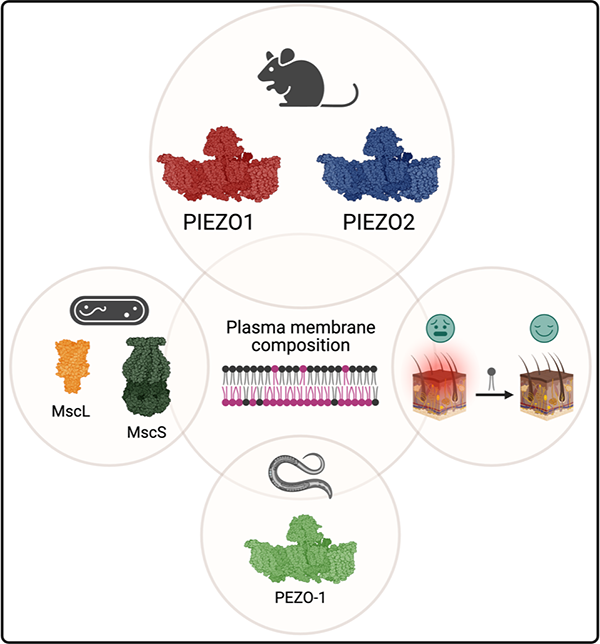Areas of Interest
Research Interests
Modulation of Mechanosensitive Ion Channels by Dietary Fatty acids
My group is working to uncover the mechanisms by which the plasma membrane modulates the function of mechanosensitive ion channels. Members of the mechanosensitive ion channel family mediate rapid cation influx in response to mechanical cues. In mammals, the PIEZO subfamily has two members: PIEZO1, a regulator of red blood cell volume, wound healing, and neuronal differentiation, and the paralogous PIEZO2 that underpins gentle touch sensation, proprioception (i.e., sense of self-movement), inflammatory pain, and musculoskeletal development. With the recent discovery that gain- and loss-of-function mutations in PIEZO channels have a detrimental effect on human erythrocyte volume, touch, balance, proprioception, and skeletal development, it has become clear that modulating their function could have therapeutic effects for a wide range of pathologies.
In my lab, we use multidisciplinary in vitro, ex vivo, and in vivo approaches to uncover the mechanism by which membrane fatty acids modulate the function of PIEZO channels. These approaches include tissue culture (cell lines, murine, and human cultured primary cells, as well as human iPSC-derived sensory neurons), electrophysiology (patch clamp), calcium imaging, lipidomics, spectroscopy, membrane protein biochemistry, atomic force microscopy, and mouse behavior among other strategies.
We also use the animal model Caenorhabditis elegans to uncover novel physiological roles of the PIEZO channel subfamily. C. elegans is a powerful model in which genetics, behavior, and physiology can synergize to reveal novel gene functions. My laboratory focuses on determining the mechanisms by which the plasma membrane modulates the function of PIEZO channels, as well as revealing novel physiological roles of this family of ion channels.

Selected Publications:
Ma S, Dubin AE, Romero LO, Loud M, Salazar A, Chu S, Klier N, Masri S, Zhang Y, Wang Y, Chesler AT, Wilkinson KA, Vásquez V, Marshall KL, Patapoutian A. Excessive mechanotransduction in sensory neurons causes joint contractures. Science. 2023 Jan 13;379(6628):201-206.
Romero LO, Caires R, Kaitlyn Victor A, Ramirez J, Sierra-Valdez FJ, Walsh P, Truong V, Lee J, Mayor U, Reiter LT, Vásquez V*, Cordero-Morales JF*. Linoleic acid improves PIEZO2 dysfunction in a mouse model of Angelman Syndrome. Nat Commun. 2023 Mar 1;14(1):1167. *Corresponding authors.
Millet JRM, Romero LO, Lee J, Bell B, Vásquez V. C. elegans PEZO-1 is a mechanosensitive ion channel involved in food sensation. J Gen Physiol. 2022 Jan 3;154(1).
Education and Training
Licentiate
Universidad Central de Venzuela
PhD
University of Virginia
Postdoctoral Fellow
Stanford University
Graduate Program Affiliations
Molecular and Translational Biology
Neuroscience
